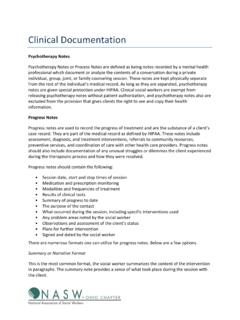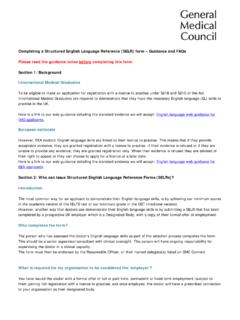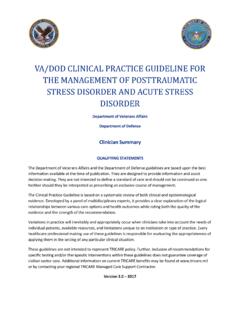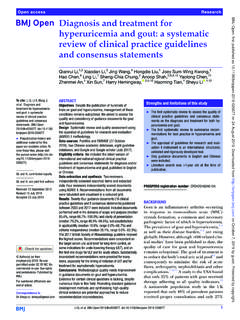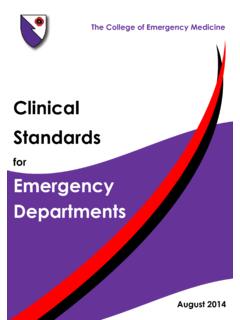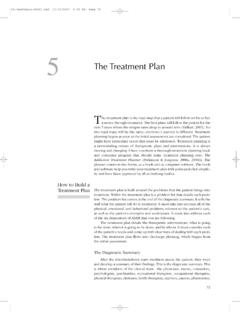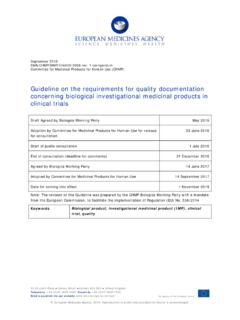Transcription of ICH E9 (R1) addendum on estimands and sensitivity analysis ...
1 1 30 August 2017. 2 EMA/CHMP/ICH/436221/2017. 3 Committee for Human Medicinal Products 4 ICH E9 (R1) addendum on estimands and sensitivity 5 analysis in clinical trials to the guideline on statistical 6 principles for clinical trials 7 Step 2b Transmission to CHMP July 2017. Adoption by CHMP for release for consultation 20 July 2017. Start of consultation 31 August 2017. End of consultation (deadline for comments) 28 February 2018. 8. 9. Comments should be provided using this template. The completed comments form should be sent to 10. 11. 30 Churchill Place Canary Wharf London E14 5EU United Kingdom Telephone +44 (0)20 3660 6000 Facsimile +44 (0)20 3660 5555. Send a question via our website An agency of the European Union European Medicines Agency, 2017.
2 Reproduction is authorised provided the source is acknowledged. 12 ICH E9 (R1) addendum on estimands and sensitivity 13 analysis in clinical Trials to the guideline on statistical 14 principles for clinical trials 15 Table of contents 16 Purpose and scope .. 3. 17 A framework to align planning, design, conduct, analysis and 18 interpretation .. 4. 19 5. 20 Description .. 5. 21 Strategies for Addressing Intercurrent Events .. 6. 22 Construction of estimands .. 9. 23 General Considerations .. 9. 24 Considerations of Therapeutic and Experimental Context .. 9. 25 Impact on trial sign and conduct .. 11. 26 Impact on trial analysis .. 12. 27 Main estimation .. 12. 28 sensitivity analysis .. 14. 29 Role of sensitivity analysis .
3 14. 30 Choice of sensitivity analysis .. 14. 31 Supplementary analysis .. 14. 32 Documenting estimands and sensitivity analysis .. 15. 33 A generic example .. 16. 34 One Intercurrent Event .. 17. 35 Two Intercurrent Events .. 20. 36 Glossary .. 22. 37. 38. ICH E9 (R1) addendum on estimands and sensitivity analysis in clinical Trials to the guideline on statistical principles for clinical trials EMA/CHMP/ICH/436221/2017 Page 2/23. 39 Purpose and scope 40 To properly inform the choices that are made by patients and prescribing physicians, clear descriptions 41 of the effects of a medicine should be available. These descriptions are complicated by the different 42 ways in which each individual patient responds to treatment.
4 Some subjects will tolerate a medicine 43 and adhere to its administration schedule, others will not. Some subjects will require changes in dose 44 of concomitant medication or administration of additional medication, others will not. Multiple ways to 45 quantify treatment effects can be envisaged based on how to take into account, for example, 46 tolerability, adherence and whether or not additional medication is required. Without a precise 47 understanding of the treatment effect that is being described, there is a risk that its magnitude and 48 meaningfulness will be misunderstood. 49 Confirmatory clinical trials, usually randomised controlled trials, are conducted to quantify the effects 50 of a treatment and to provide evidence of efficacy and safety to support regulatory decision making.
5 51 Randomised trials are expected to be free from baseline confounding but, in trials as in clinical 52 practice, certain events will occur that complicate the description and interpretation of treatment 53 effects. In this addendum , these are denoted as intercurrent events (see Glossary) and include, among 54 others, use of an alternative treatment ( a rescue medication, a medication prohibited by the 55 protocol or a subsequent line of therapy), discontinuation of treatment, treatment switching and 56 terminal events such as, in some circumstances, death. 57 Choosing and defining efficacy and safety variables as well as standards for data collection and 58 methods for statistical analysis without first addressing the occurrence of intercurrent events will lead 59 to ambiguity about the treatment effect to be estimated and potential misalignment with trial 60 objectives.
6 The correct order is the reverse. Having clarity in the trial objectives and accounting 61 explicitly for intercurrent events when describing the treatment effect of interest at the planning stage 62 should inform choices about trial design, data collection and statistical analysis . 63 This addendum presents a structured framework to link trial objectives to a suitable trial design and 64 tools for estimation and hypothesis testing. This framework introduces the concept of an estimand 65 (see Glossary), translating the trial objective into a precise definition of the treatment effect that is to 66 be estimated (Section ). It aims to facilitate the dialogue between disciplines involved in clinical 67 trial planning, conduct, analysis and interpretation, as well as between sponsor and regulator, 68 regarding the treatment effects of interest that a clinical trial should address.
7 The statistical analysis , 69 aligned to the estimand, will be associated with assumptions and data limitations, the impact of which 70 can be investigated through sensitivity analysis (see Glossary). This addendum clarifies the definition 71 and the role of sensitivity analysis . References to the original ICH E9 are made using References 72 within this addendum are made using 73 This addendum clarifies and extends ICH E9 in a number of respects. 74 Firstly, ICH E9 introduced the intention-to-treat (ITT) principle in connection with the effect of a 75 treatment policy, the effect of treatment initially assigned at baseline, regardless of adherence to 76 the planned course of treatment, indicating that preservation of randomisation provides a secure 77 foundation for statistical tests.
8 It remains undisputed that randomisation is a cornerstone of controlled 78 clinical trials and that analysis should aim at exploiting the advantages of randomisation to the 79 greatest extent possible. However, the question remains whether understanding the effect of a 80 treatment policy always targets the treatment effect of greatest relevance to regulatory and clinical 81 decision making. The framework outlined in this addendum gives a basis for discussing other 82 treatment effects and some points to consider for the design and analysis of trials to give estimates of 83 these treatment effects that are reliable for decision making. ICH E9 (R1) addendum on estimands and sensitivity analysis in clinical Trials to the guideline on statistical principles for clinical trials EMA/CHMP/ICH/436221/2017 Page 3/23.
9 84 Secondly, issues considered generally under data handling and missing data (see Glossary) are re- 85 visited. On one hand, intercurrent events such as discontinuation or switching of treatment, or use of 86 rescue medication, may in some circumstances render the later measurements of the variable 87 irrelevant or difficult to interpret even when it can be collected. In the case of death, measurements 88 after a subject dies do not exist. On the other hand, ICH E9 noted the difficulty of fulfilling the ITT. 89 principle when clinical trial subjects discontinuing treatment were lost to follow up. This addendum 90 invites consideration of the important distinction between non-adherence with, or withdrawal from, 91 randomised treatment and discontinuation from the trial; also between measurements that exist but 92 have not been collected, and measurements that do not, or cannot, exist.
10 Having clarity in the 93 estimand gives a basis for planning which data need to be collected and hence which data, when not 94 collected, present a missing data problem to be addressed. In turn methods to address the problem 95 presented by missing data can be selected to align with the chosen estimand. 96 Thirdly, the concept of analysis sets is considered in the proposed framework. Section strongly 97 recommends that analysis of superiority trials be based on the full analysis set, defined to be as close 98 as possible to including all randomised subjects. However, trials often include repeated measurements 99 on the same subject. Elimination of some planned measurements on some subjects, perhaps because 100 the measurement is considered irrelevant or difficult to interpret, can have similar consequences to 101 excluding subjects altogether from the full analysis set, that the initial randomisation is not fully 102 preserved.










